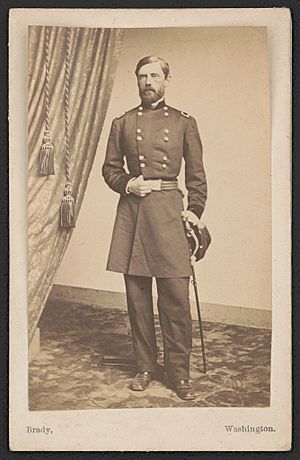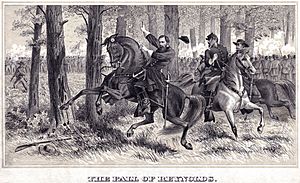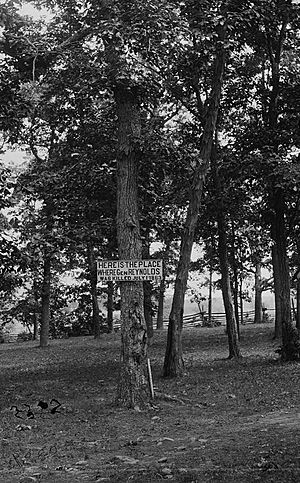John F. Reynolds facts for kids
Quick facts for kids
John Reynolds
|
|
|---|---|
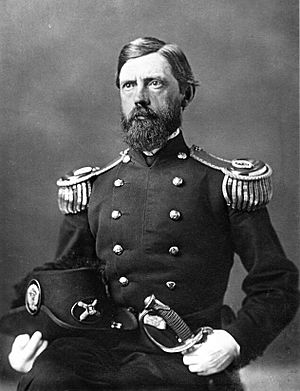 |
|
| Born | September 21, 1820 Lancaster, Pennsylvania |
| Died | July 1, 1863 (aged 42) Gettysburg, Pennsylvania |
| Place of burial |
Lancaster Cemetery, Lancaster, Pennsylvania
|
| Allegiance | United States of America Union |
| Service/ |
United States Army Union Army |
| Years of service | 1841–1863 |
| Rank | |
| Commands held | I Corps, Army of the Potomac |
| Battles/wars | Mexican–American War |
John Fulton Reynolds (born September 21, 1820 – died July 1, 1863) was a brave officer in the United States Army. He became a general during the American Civil War. Reynolds was one of the most respected leaders in the Union Army. He played a very important role at the Battle of Gettysburg. Sadly, he was killed right at the start of this major battle.
Contents
John Reynolds' Early Life and Military Start
Reynolds was born in Lancaster, Pennsylvania. He was one of nine children in his family. His brothers included James LeFevre Reynolds, who was a Quartermaster General for Pennsylvania, and Rear Admiral Will Reynolds in the Navy.
John Reynolds went to school in nearby Lititz. He also studied in Long Green, Maryland, and at the Lancaster County Academy.
Joining the Army and Fighting in Mexico
In 1837, Senator James Buchanan, a family friend, helped Reynolds join the United States Military Academy. He graduated in 1841. After West Point, he became a brevet second lieutenant.
He was sent to different forts, including Fort McHenry and Fort Moultrie, South Carolina. Later, he joined Zachary Taylor's army for the Mexican–American War. During this war, he was promoted twice for his bravery. He became a captain at the Battle of Monterrey. He was also promoted to major after the Battle of Buena Vista. His cannons helped stop the Mexican cavalry from attacking the American army's side. In Mexico, he became friends with other officers like Winfield Scott Hancock and Lewis Addison Armistead.
Life Before the Civil War
After the Mexican War, Reynolds was stationed in places like Fort Preble, Maine, and New Orleans, Louisiana. He then moved west to Fort Orford, Oregon, in 1855. He took part in the Rogue River Wars in 1856. He also served in the Utah War against the Mormons in 1857–58.
From 1860 to 1861, he was in charge of the cadets at West Point. He also taught artillery, cavalry, and infantry tactics. On his way back from the West, Reynolds got engaged to Katherine May Hewitt. They kept their engagement a secret because they had different religious beliefs. Her parents did not know until after his death.
John Reynolds in the Civil War
When the Civil War began, Reynolds was offered a job as an aide to Lt. Gen. Winfield Scott, but he said no. He was promoted to brigadier general in August 1861. He was then assigned to the new Army of the Potomac. His first job was to check if volunteer officers were good enough. Soon, he was given command of a brigade of Pennsylvania Reserves.
Early Battles and Capture
In 1862, during the Peninsula Campaign, Reynolds and his brigade took over Fredericksburg, Virginia. His brigade then joined the V Corps near Mechanicsville. This was just before the Seven Days Battles. His brigade fought hard at the Battle of Beaver Dam Creek on June 26. Their defensive line held strong. Reynolds received praise from his commander, Brig. Gen. George A. McCall.
The fighting continued on June 27 at the Battle of Gaines' Mill. Reynolds was very tired and had not slept for two days. He was captured in Boatswain's Swamp, Virginia. He thought he was safe and fell asleep. His troops had retreated and left him behind. He was very embarrassed when he was brought before the Confederate general, D.H. Hill. Hill was a friend from before the war. Hill reportedly told him, "Reynolds, do not feel so bad about your capture, it is the fate of wars." Reynolds was taken to Richmond and held at Libby Prison. He was quickly exchanged for another prisoner on August 15.
Key Role at Second Bull Run
When he returned, Reynolds was given command of the Pennsylvania Reserves Division. On the second day of the Second Battle of Bull Run, most of the Union Army was retreating. Reynolds led his men in a brave stand on Henry House Hill. This was the same place where the Union Army had suffered a big defeat the year before.
Waving the flag of the 2nd Reserves regiment, he shouted, "Now boys, give them the steel, charge bayonets, double quick!" His counterattack stopped the Confederate advance. This gave the Union Army time to retreat in a more organized way. Many believe this was key to preventing the army from being completely destroyed.
Fredericksburg and Chancellorsville
At the request of Pennsylvania Governor Andrew G. Curtin, Reynolds took command of the Pennsylvania Militia. This happened during General Robert E. Lee's invasion of Maryland. Because of this, Reynolds missed the Battle of Antietam. He spent two weeks in Pennsylvania training older men and boys.
He returned to the Army of the Potomac in late 1862. He took command of the I Corps. At the Battle of Fredericksburg, one of his divisions, led by Maj. Gen. George G. Meade, made the only breakthrough. However, Reynolds did not send his other two divisions to help. The attack failed. Reynolds was promoted to major general after the battle.
At the Battle of Chancellorsville in May 1863, Reynolds disagreed with Maj. Gen. Joseph Hooker, who was now the commander of the Army of the Potomac. Hooker moved Reynolds' I Corps around a lot. The I Corps was not in position when the XI Corps was surprised by Lt. Gen. Thomas J. "Stonewall" Jackson's attack. This made Hooker lose his courage for attacking.
Hooker called a meeting on May 4. Reynolds voted to keep fighting. But Hooker decided to retreat. Reynolds, who had been asleep, woke up and said loudly enough for Hooker to hear, "What was the use of calling us together at this time of night when he intended to retreat anyhow?" The I Corps, with 17,000 men, was not heavily involved in this battle. They had only about 300 casualties.
Reynolds and other officers wanted Hooker to be replaced. Reynolds had also spoken out against Maj. Gen. Ambrose Burnside after Fredericksburg. President Abraham Lincoln met with Reynolds on June 2. It is thought that Lincoln asked him if he would lead the Army of the Potomac. Reynolds reportedly said he would, but only if he had complete control. He wanted to be free from political influences. Lincoln could not agree to his demands. So, on June 28, Lincoln promoted George G. Meade to replace Hooker.
The Battle of Gettysburg and Reynolds' Death
On the morning of July 1, 1863, Reynolds was in charge of the "left wing" of the Army of the Potomac. This included the I, III, and XI Corps, plus Brig. Gen. John Buford's cavalry division. Buford's cavalry was in Gettysburg, Pennsylvania. They set up defenses north and west of the town. They held off two Confederate infantry brigades until Reynolds' I Corps arrived.
Reynolds rode ahead to meet Buford. He then went with some of his soldiers into the fighting at Herbst's Woods. Troops from Brig. Gen. Solomon Meredith's Iron Brigade began to arrive. As Reynolds was helping position the 2nd Wisconsin regiment, he shouted, "Forward men forward for God's sake and drive those fellows out of those woods." At that moment, he fell from his horse. He had been shot in the back of his upper neck or lower head. He died almost instantly. Command then went to his senior officer, Maj. Gen. Abner Doubleday.
For the Union side, the death of John Reynolds meant more than the loss of an inspiring leader; it also removed from the equation the one person with enough vision and sense of purpose to manage this battle.
The army felt the loss of General Reynolds deeply. His soldiers loved him, and other generals respected him. Historian Shelby Foote wrote that many thought he was "not only the highest ranking but also the best general in the army."
His death had a big impact that day. By supporting Buford's plan and sending his I Corps into battle, Reynolds basically chose the location for the Battle of Gettysburg. This turned a small fight into a huge battle. The Union forces were at first outnumbered. After Reynolds' death, the two Union corps that arrived were pushed back. They had to retreat through Gettysburg to higher ground south of town. There, his old friend, Maj. Gen. Winfield S. Hancock, rallied them.
Reynolds' body was taken from Gettysburg to Taneytown, Maryland, and then to his hometown, Lancaster, Pennsylvania. He was buried on July 4, 1863.
Kate Hewitt, his fiancée, had promised Reynolds that if he died in the war, she would join a convent. After his burial, she went to Emmitsburg, Maryland. She joined the St. Joseph Central House of the Order of the Daughters of Charity.
Monuments and Memorials Honoring John Reynolds
John Reynolds is remembered with several statues and memorials.
| John F. Reynolds memorials | |||||
|---|---|---|---|---|---|
 |
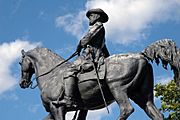 |
 |
 |
 |
 |
| Equestrian statue on McPherson Ridge, Chambersburg Pike, Gettysburg National Military Park, general view and closeup | Statue by John Quincy Adams Ward in the National Cemetery, Gettysburg National Military Park | In front of Philadelphia City Hall | Gettysburg, Penna | ||
There is also a John F. Reynolds Middle School in Lancaster, Pennsylvania, named in his honor.


